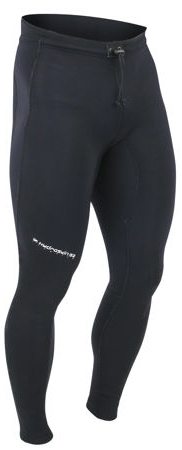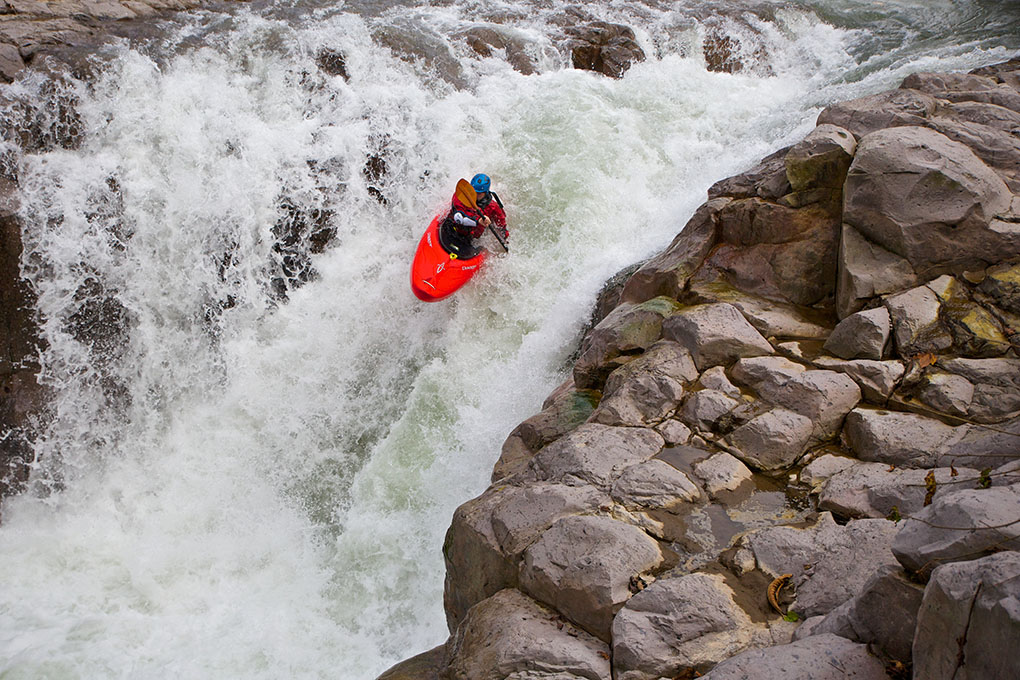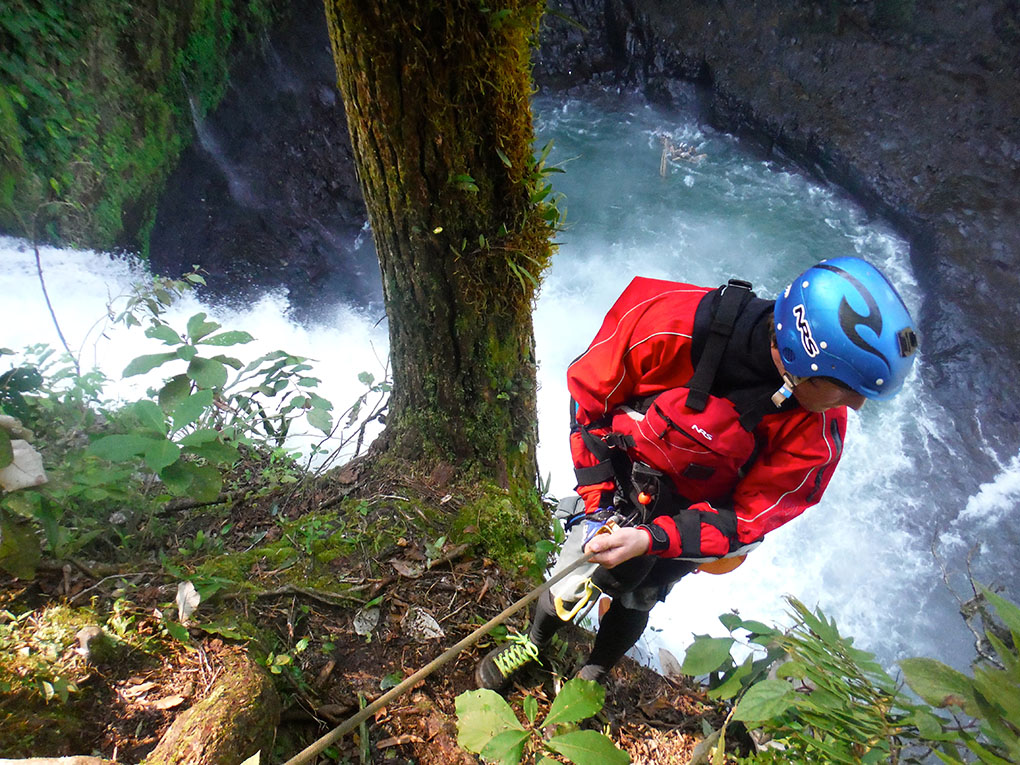
Men’s NRS 0.5mm HydroSkin Pants
Size: Large
Material: 75% neoprene, 25% nylon.
MSRP: $99
Reviewer info: 5’10’’, 30” inseam, 165 lbs.
Days tested: 15
Test Locations: Rivers of Veracruz, Mexico: Alseseca, Jalacingo, Rio Oro
The NRS Hydroskin line offers boaters a number of extremely versatile layering options for a range of paddling conditions. This December, while packing for a paddling trip to Veracruz, Mexico, I elected to bring the 0.5mm HydroSkin pant. (See our Trip Report and Guide to Paddling Veracruz, Mexico.)
Several factors played into this decision. I knew that the weather would probably dip down into the 50-60° F range during our trip, with a high likelihood for rain in the jungle environment. I also felt that bringing a drysuit would be overkill considering those temperatures, and it’s a large item to pack for an international trip in addition to a drytop.
The Hydroskin pants are made for moderately cool temperatures, they pack down small, and are much more versatile than bringing a full length wetsuit or farmer john.
Design & Features
The HydroSkin pants are designed to fit tight, as they’re basically just the bottom half of a thin wetsuit. A draw string around the waist keeps the pant from sliding down, and the rear of the waist comes up slightly higher up the back to prevent plumbers crack and protect against chafing on my backband while in the boat.
This is a simple neoprene pant so there aren’t many features to go over. There is a small zippered pocket on the rear of the pants that can fit a small car key or similar items, but I haven’t found a use for it so far given that I am almost always sitting down while wearing these pants—this is kayaking, after all.

Fit
Despite being designed to fit snuggly as tights, the HydroSkin remain flexible and do not noticeably restrict movement. 0.5mm of neoprene is thinner than most wetsuits/neoprene layers, but it still feels a lot heavier/thicker than long johns or thin fleece pants.
I tested the Hydroskin in a size Large, but think I could move down to the Medium without limiting mobility. With a 30” inseam, I am right on the border between the Large and Medium. In the Large I have just a bit of bagginess around my knees and over my quads, but I think I’ll stick with it as I feel like the pants would be difficult to pull over my ankle in a smaller size.
The material on these pants is very smooth, which makes them easy to take off and put on even when wet (which is pretty much everyday if you are paddling multiple days in a row).
This is totally subjective, and not all that important, but in my opinion the HydroSkin pants can look somewhat silly when worn simply as tights. I took to wearing board shorts over mine, so as to try to maintain the cool factor, and I did not have any problems with the pants bunching up or forming wedgies, which I have had happen when wearing normal long johns underneath shorts.

Personally, I choose to go commando underneath my Hydroskin pants. This particular neoprene is soft/smooth enough that I didn’t have any problems whatsoever with chafing, and the flat stitched seams are comfortable against bare skin.
Warmth, Versatility, and Best Uses
The 0.5mm version of the HydroSkin pants work best at moderate temperatures, but are suitable in a surprisingly wide range of conditions. This is hugely beneficial because even a warm day can feel cold with a bit of wind, a swim, or in a rescue situation. Conversely, a cold day can feel warm when working hard on a portage or during a hike to the put-in. I dealt with a number of these sorts of situations on my trip to Mexico with the pants, and they performed well across the board. The 0.5mm Hydroskin is thin enough to be worn on a warm day, but still provides a lot of warmth for chilly temps.
In addition to being insulative, the pants do a great job of shedding water. This mitigates evaporative cooling, especially in the wind, which is a major downfall of wearing long underwear or wool/fleece pants as your bottoms.
Overall I would say the temperature range for this garment is approximately 45-70° F. Any warmer, and I could just wear shorts. Colder, and I would either upgrade to a more substantial neoprene layer or start thinking about investing in dry pants or a drysuit.
I did a lot of portaging in the pants in Mexico that required wading or standing for extended periods of time in deep pools of water. I found that I stayed warm enough even after several minutes or more of standing in 50° F water.
Neoprene Pants vs. Full Wetsuit
There are several advantages to selecting neoprene pants instead of a full wetsuit. The first is mobility. Many wetsuits can feel constricting, and don’t bend well at the waist. The 0.5mm thickness of these pants is thinner than most wetsuits, adding to mobility and decreasing bulk. Full wetsuits are also bulky underneath a drytop and limit your layering options. With a pair neoprene pants, you’ll get the warmth advantages of neoprene on your exposed legs, while still being able to layer completely with fleece or wool underneath your drytop. As an extra bonus, neoprene pants allow you to go to the bathroom in more dignified ways, without needing to disrobe entirely like you would with a wetsuit.
Personally, I would not use these pants as a layering piece beneath dry wear. Although it can be done, I prefer wool or synthetic thermal layers to wear under dry pants or a suit, since even the thinnest of neoprene layers like the Hydroskin are still bulky in comparison.

Dear David,
Thanks for the review. I wonder if I can wear this as a protection when (shortly!) falling into 50 degree cold water during kajaking in spring/autumn. I am sure it is superbe to wear against cold air temperatures. But what nobody writes about is how good it is when falling into cold water for a short period of time.
Can you give any recommendation there?
Many thanks,
Benjamin
I do a lot of ocean swimming and I am looking for jelly fish protection. I do not like ankle to wrist wet suits because they are too bulky. I thought the .5mm would be a perfect fit. Any thoughts to see if this could be beneficial. Thanks